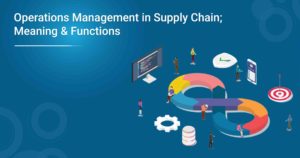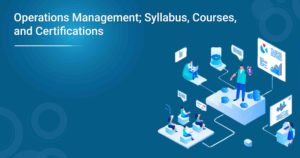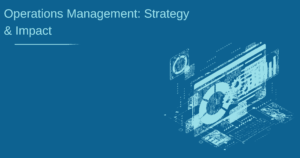Operations and production management is a field of business concerned with designing, planning, and controlling an organisation’s operations. It includes managing raw materials, human resources, and equipment. There are many different functions of production and operations management. Still, the ultimate goal is to ensure all the products or services are produced and delivered promptly and efficiently. To achieve this, businesses must carefully plan and control all aspects of their operations.
You will learn about the functions of production and operations management in detail through this blog.
If you want to discover the nitty-gritty of operations and supply chain management, we have an insightful course with the perfect blend of flexibility and expertise you require. Check out the course right away!
Production Planning And Control
The production planning and control functions of production and operations management ensure that the organisation’s production activities are coordinated and aligned with its overall objectives. It includes developing and maintaining production schedules, coordinating materials and resources, and monitoring production progress.
Production planning and control aim to ensure that the organisation’s production activities are efficient and effective and that they promptly meet customers’ needs. To do this, production planners and controllers must have a good understanding of the organisation’s overall objectives, as well as the specific goals of the production department. They must also be familiar with the various processes and activities involved in production to identify potential bottlenecks or areas of inefficiency.
Production planning and control is a complex task, and it is essential to have systems and procedures in place to ensure that it is done effectively. A manufacturing execution system (MES) is one essential tool that can support production planning and control. MES software provides a centralised platform for managing all aspects of production, from scheduling to materials management to quality control.
By using an MES, organisations can improve communication among all stakeholders involved in production, including engineers, managers, operators, and suppliers. It can lead to better coordination of resources and improved overall efficiency.
Financial Planning
To ensure that a company is running smoothly and efficiently, production and operations managers must perform various financial planning functions. It includes creating budgets, forecasting sales and costs, and analysing financial data. By doing so, they can ensure that the company has enough money to cover its expenses and continue growing.
One of production and operations managers’ most important financial planning functions is creating budgets. It involves estimating how much money the company will need to cover its costs and achieve its goals for the upcoming year. The budget must be realistic, achievable, and flexible enough to account for unexpected expenses.
Also Read: Objectives Of Supply Chain Management Explained
Forecasting sales and costs is another crucial financial planning function for production and operations managers. It allows them to make informed decisions about where to allocate resources and helps them plan for future growth and avoid financial problems. They use historical data, market trends, and other information to predict how much revenue the company will generate and what its expenses will be.
Finally, production and operations managers must analyse financial data regularly. This helps them identify problem areas and find ways to improve the company’s financial performance. They also use this information to monitor budget compliance and forecast sales and costs. By staying on top of the numbers, they can keep the company’s finances healthy and ensure its long-term success.
Process Design
Process design is the heart of any manufacturing or service organisation. It involves creating and continuously improving processes to produce products or services with desired quality, cost, and speed levels. Process design aims to create a process that will meet customer needs while achieving the company’s strategic objectives.
The process design must take into account the resources available to the company, as well as the company’s culture and values. The process should be designed so employees can easily understand and follow it. It should also be flexible enough to accommodate marketplace or customer needs changes.
Many different tools and techniques can be used in process design. Some common ones include value stream mapping, Lean Six Sigma, and the Theory of Constraints. The choice of which tool or technique to use depends on the specific situation and needs of the company.
Product Design
Product design is creating a new product or enhancing an existing one. It involves the identification of customer needs and desires, the development of specifications for the product, and the creation of prototypes. Product design aims to create a product that meets the customer’s needs while also being profitable for the company.
There are several steps involved in product design:

- Identifying customer needs and desires: This step involves researching what customers want and need from a product. This can be done through surveys, interviews, focus groups, and other research methods.
- Developing specifications for the product: Once customer needs have been identified, specifications must be developed. These specifications will include things like size, weight, durability, etc.
- Creating prototypes: Once specifications have been developed, prototypes can be created. These prototypes will be used to test how well the product meets customer requirements and make it feasible to produce on a large scale.
- Testing and refining: After creating prototypes, they must be tested extensively to identify any problems. Once all issues have been addressed, the product is ready for mass production.
Plant Layout and Material Handling
In production and operations management, plant layout is the arrangement of facilities within a factory. It is the facility’s physical arrangement of workstations, machinery, and support areas. Plant layout aims to create an efficient workplace that minimises wasted space and time.
Material handling is the movement of raw materials, work in progress, and finished goods within a factory. It includes receiving, storing, retrieving, and shipping products. Material handling aims to reduce the time and cost of moving materials around the factory.
Maintenance Management
Maintenance management is the process of managing the maintenance of equipment and machinery. It includes planning, scheduling, and executing maintenance activities. Maintenance management is essential for ensuring that equipment is properly maintained and operated safely and efficiently.
Poorly maintained equipment can be unsafe and lead to accidents or downtime. Inefficiently maintained equipment can cost more and may not function as intended. Organisations can improve safety, reduce costs, and improve equipment performance by properly managing maintenance.
Material Management
Material management is the process of handling and storing raw materials. It includes sourcing, procurement, warehousing, and quality control tasks. Material management aims to ensure that the correct materials are available when needed while minimising waste and cost.
An essential part of material management is forecasting. Forecasting is based on historical data, trends, and customer demand. It helps production planners know what materials will be needed in the future so they can be procured in advance.
Inventory control is another key function of material management. This involves keeping track of stock levels and ensuring that materials are available when needed. Inventory control also helps to minimise wastage and obsolescence.
Quality Control
Product quality control and assurance are the activities designed to ensure that products meet or exceed the expectations of customers or other interested parties. Quality control can involve tasks such as inspection, testing, and certification. Quality control is another important aspect of material management. This ensures that materials meet the required standards before being used in production.
Quality control is a process that includes inspection, testing, and taking corrective action as necessary to ensure that products meet quality standards. Quality assurance is a process that establishes quality standards and ensures that the techniques used to produce products meet those standards.
Also Read: What Is The Scope Of Operations Management?
Product quality control begins with the development of quality standards. These standards may be based on customer requirements, regulatory requirements, or the product’s characteristics. Once quality standards have been established, they must be communicated to all employees who are involved in producing the product.
Inspection is one of the most common methods used to control product quality. The inspection involves examining products to see if they meet quality standards. Inspections can be done at various stages of production, including incoming inspection (of raw materials), in-process inspection (of partially completed products), and final inspection (of completed products).
Forecasting
Forecasting is one of the critical functions of production and operations management. Forecast demand can help managers make decisions about production levels, workforce needs, inventory levels, and other factors that affect the company’s bottom line. By forecasting future demand, production and operations managers can ensure that the necessary resources are available when needed.
Strategy Planning
Strategy planning is developing a company’s long-term goals and objectives. Strategic planning aims to create a road map for the company that will guide it through its journey to success. To develop an effective strategy, companies must first understand their current position and the environment in which they operate. They must also identify their target market and understand the needs of their customers. Once these things are understood, companies can begin developing a plan to help them achieve their goals.
There are a few key components to any good strategy:

1) A clear understanding of the company’s strengths and weaknesses.
2) A realistic assessment of the opportunities and threats facing the company.
3) Clear goals and objectives aligned with the company’s strengths.
4) Specific strategies and tactics that will be used to achieve the goals.
5) A timeline for implementation.
6) Regular monitoring and evaluation to ensure the plan is on track.
Supply Chain Management
Supply chain management (SCM) is a process that starts with procuring raw materials and ends with delivering finished products to the customer. Several steps are required to transform the raw materials into a finished product.
The first step in SCM is procurement, which is acquiring the raw materials needed for production. The next step is manufacturing, which is transforming raw materials into finished products. Finally, there is distribution, which delivers the finished products to the customer.
Each of these steps requires different skills and knowledge to be completed successfully. For example, procurement involves an understanding of the market and an ability to negotiate prices with suppliers. Manufacturing requires an understanding of production processes and an ability to troubleshoot problems that arise during production. Distribution involves an understanding of logistics and an ability to ensure that products are delivered on time and in good condition.
Operations management ensures that all of these steps are completed efficiently and effectively. This includes designing efficient production processes, developing effective procurement strategies, and planning efficient distribution routes. It also includes monitoring all aspects of SCM to identify potential problems and implement solutions to improve performance.
What Is The Difference Between Production and Operations Management?
Production and operations management are two different but related fields. Production management is concerned with the day-to-day running of a production facility, ensuring that products are produced with utmost efficiency. On the other hand, operations management focuses on long-term strategic planning, setting goals and objectives for the organisation’s future.
While both production and operations managers must know the big picture, their day-to-day responsibilities differ. Production managers ensure that products are manufactured safely, on time, and within budget. They oversee all aspects of production, from raw materials procurement to shipping finished products to customers. Meanwhile, operations managers develop plans to improve efficiency and quality control, set goals for the organisation’s future growth, and make decisions about where to allocate resources.
In short, production managers focus on the here and now, while operations managers look to the future. Both play vital roles in ensuring that an organisation runs smoothly and efficiently.
Conclusion
Functions of Production and operations management are vital to any organisation’s success. Production and operations managers ensure that products and services are produced efficiently and effectively and meet all quality standards. They also play a crucial role in planning and forecasting future demand and managing inventory levels. By understanding the importance of these functions, organisations can ensure that their production and operations are running smoothly and efficiently, ultimately leading to tremendous success.
Check out our course Advanced Certificate in Operations, Supply Chain and Project Management to learn everything about operations management and more. Check out the detailed course and make a decision now.
More Information:
What Is Capacity Planning In Operations Management?
What Are The Objectives Of Operations Management?





























